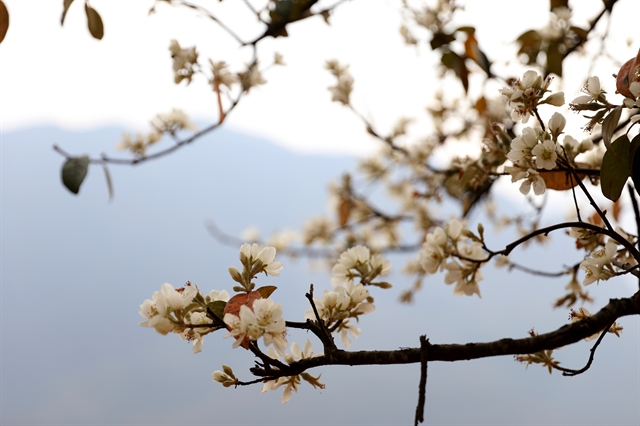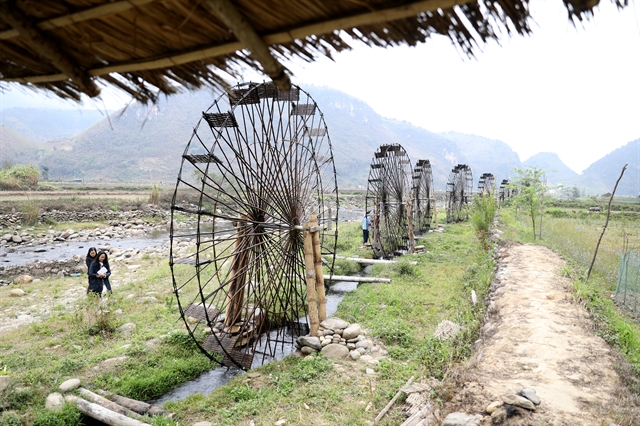Weather:
- Ha Noi 26oC
- Da Nang 27oC
- Ho Chi Minh 26oC

By Thanh Nga
Standing at 2,400m above sea level, amidst a vast forest of sơn tra or assam apple (Docynia indica) trees in blossom, swaying in the wind, our trip to Nậm Nghẹp Village feels like we were traversing a dreamy fairyland.
The clouds kept appearing from the far corner of the forest, spilling over the top of the mountains and then dissolving, leaving behind delightful spots of sun glistening through the trees. The mountain slopes and surrounding villages were bathed in the pure white of sơn tra (also known as táo mèo) blooms, adding to the poetic and charming scene.
The assam apple blossom is the signature of the northwest region, offering opportunities for the tourist industry in Nậm Nghẹp of Ngọc Chiến Commune in Mường La District of Sơn La Province.

Though the trees once grew naturally in the wild, locals now plant them throughout the village. Flowers have five petals with yellow pistils, alternating with brown, bringing a natural and simple beauty.
There are various ways to go from Hà Nội to Nậm Nghẹp, and we chose Lào Cai Highway. We went through Yên Bái Province, to Văn Chấn District, passing Nghĩa Lộ Town, and then through the misty Khau Phạ Pass in Mù Cang Chải District. Crossing the top of the pass, down most of the slope, we continued through sparsely populated pine forests and dry streams until we arrived in the village.

March is the time when the trees bloom most beautifully. On these days, from early morning, lines of cars and motorbikes rush over the zigzag mountain road to the village.
Ngọc Chiến Commune has 2,565ha of assam apple trees, of which more than 1,400ha have produced flowers and fruits. It has just established a national record as the commune with the largest assam apple forest in Việt Nam.
"Nậm Nghẹp Village has 1,650ha of the trees. They bring very high economic value. The colour of the flower represents and symbolises the culture of the Mông ethnic people. That's why it has become a tourism product representing the Mông ethnicity for economic development in the future," Bùi Tiến Sỹ, the Communist Party secretary of Ngọc Chiến Commune, told Việt Nam News.
Nậm Nghẹp is an all-ethnic Mông village sitting separately from the other villages. The village has 130 houses hidden under beautiful assam apple canopies. On weekends, many people flock here for sightseeing.
Mixed among the vast expanse of the exotic white flowers, with a little yellow and pink light and the faint scent fluttering in the wind are the elaborately hand-embroidered colourful costumes of the Mông girls, photographers carrying spare lenses, groups of tourists wearing áo dài (traditional long dress), backpackers who have temporarily made the area their home, and painters looking to set up their easels alongside the locals playing folk games, singing, and dancing.
"I learned that assam apple gardens are in bloom in Ngọc Chiến, so our group came here to explore the wild beauty of this land. I am delighted to see it as well as immerse myself in the fresh nature and learn more about the culture and life of the Mông," said Lục Thế Anh, a tourist from Hà Nội.
"Visitors come early in the morning or at sunset for the best experience. There's a coffee shop at the top of the village's highest hill, where visitors can enjoy watching the sunset and the panoramic views of the flower-covered area below."

Assam apple blossoms not only draw tourists near and far, but also produce profitable fruit, giving local people more income.
"Ngọc Chiến’s assam apple trees yield about 3,000 tonnes of fruit per year. If the price is stable, each household in the commune can earn from VNĐ100 million to 500 million (US$4,000 - $20,000)," Sỹ said.
Every year, by September and October, the fruit is ready for harvest for various culinary uses, from making wine to various sweet treats.
"My family has more than 100 trees. During the harvest season, I sell the fruit for around VNĐ20,000 per kilo, bringing good money to my family," said Thào A Vạng, owner of a homestay in Nậm Nghẹp
Hidden gem
Ngọc Chiến, a picturesque commune nestled at 1,800m above sea level, is a hidden gem waiting to be discovered.
According to Sỹ, with its 87 per cent forest coverage, the climate remains cool year-round, and the natural scenery is nothing short of majestic.

The commune boasts remarkable natural resources, including 11 hot springs, the record area of assam apple trees in the country, over 1,000ha of ancient tea trees in primaeval forests, 300ha of natural pine forests, and more than 300ha of bamboo. Additionally, Ngọc Chiến is adorned with enchanting caves and captivating waterfalls.
Recognising the potential of its natural resource advantages, the people of Ngọc Chiến are focusing on developing homestay services to cater to visitors seeking an immersive experience. Presently, the commune offers 32 homestays and motels, ensuring ample accommodations.

Among these, Ngọc Chiến Pearl homestay stands out as unique, beautifully blending traditional and modern architectural styles. Situated on a 5,000sq.m area halfway up the hill of Nà Tâu Village, the house captures the essence of the northwest mountains and forests. The homestay's landscape is thoughtfully arranged, featuring lush green grass, vibrant flower gardens, and soothing streams.
Ngọc Chiến encompasses a total natural area of 21,200ha, comprising 15 villages and is home to the Thái, Mông, and La Ha ethnic groups. The commune's distinct feature lies in its charming stilt houses with roofs made of pơ mu (Fokienia) wood.
"During the festival season, my family welcomes about 60-70 guests every day. Visitors can experience the local way of life and immerse themselves in the ethnic culture," A Vạng, owner of A Vạng homestay, said.
Ngọc Chiến also entices tourists with its hot mineral springs, with Lướt Village a popular destination. These hot springs meander through the village, believed to bestow a light complexion, reduce stress, and restore health. Locals often take refreshing baths in the morning before commencing their day's work, and again in the late afternoon to rejuvenate.

"My family is fortunate to be located near a hot spring. After learning from local practices, we decided to build one or two communal bathing pools and private bathrooms to cater to tourists. Since then, we have been offering hot mineral baths and ethnic cuisine to guests," said Lò Thị Hà, the owner of Văn Thưởng homestay in Lướt Village.
Lò Văn Sương, a visitor from Sơn La City, expressed his delight at bathing in hot mineral water in Ngọc Chiến. He found the experience to be relaxing, comforting and invigorating.
Aside from mineral baths, visitors to Ngọc Chiến can savour the flavours of Thái cuisine - a culinary tradition that is among the oldest in the region. The local delicacies include delectable wines, grilled chicken and fish, fresh vegetables, and sticky rice.
Ngọc Chiến is a diamond in the rough, offering a blend of natural wonders, cultural richness, warm hospitality, and unforgettable experiences. It is pitch-perfect for travellers seeking an authentic and sustainable escape in Việt Nam’s enchanting northwest. VNS


